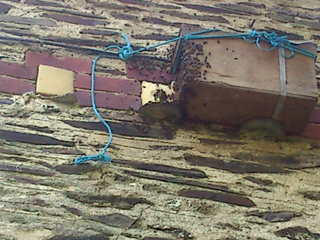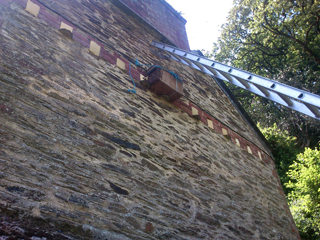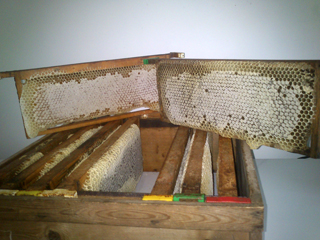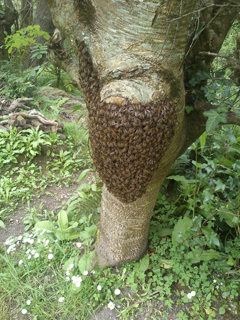 Well, what a few weeks these have been! As I said last month, I had been dealing with a lot of swarm calls, diverting them mainly to other beekeepers across Cornwall depending on locality, but I have had an increased number of calls on the Roseland and just beyond compared to previous years. The problem is firstly the mild winter. Normally, during a cold winter, the queen slows down, or even stops, laying but in a mild winter she will carry on laying .
Well, what a few weeks these have been! As I said last month, I had been dealing with a lot of swarm calls, diverting them mainly to other beekeepers across Cornwall depending on locality, but I have had an increased number of calls on the Roseland and just beyond compared to previous years. The problem is firstly the mild winter. Normally, during a cold winter, the queen slows down, or even stops, laying but in a mild winter she will carry on laying .
This year was very cold in the early part of March (though April was little better) which prevented early examination of the colonies to see how they were doing for space. Because of the queen’s continuing laying during he winter, the colonies very quickly grew to a point where either the queen had no more room in which to lay her eggs, or there was no room to store the nectar that was being brought home (plus there were combs already occupied by the wbees’ winter stores).
 Result? Congestion – a prime cause of swarming in bee colonies and one which all beekeepers are taught about and are trained to avoid. What is odd about this year, though, is where the swarms are landing up. I have never had so many calls about bees in chimneys, whilst I have also never had to retrieve so many swarms from blackthorn hedges – both very prickly problems in their own way! Something is happening in the bee world and I haven’t quite got to grips with it yet.
Result? Congestion – a prime cause of swarming in bee colonies and one which all beekeepers are taught about and are trained to avoid. What is odd about this year, though, is where the swarms are landing up. I have never had so many calls about bees in chimneys, whilst I have also never had to retrieve so many swarms from blackthorn hedges – both very prickly problems in their own way! Something is happening in the bee world and I haven’t quite got to grips with it yet.
One interesting situation I had this past month was an old stone-built property with 10 (yes, ten!) dovecote openings in the side wall of the house. Needless to say, a swarm of bees found these openings very handy to build a nest in so I was called out to remove them. I started by blocking off the openings that did not have bees flying in and out, gradually working my way towards the main centre of activity (this, of course, was up a fully extended 22′ ladder, leaning at a very shallow angle against the wall, above a deep, sloping roof!).
 The bees were using 3 dovecote openings, but one was obviously the prime entrance, so I closed the neighbouring 2 openings and placed in the final one a block of foam with a 1” diameter pipe going through it with a hive roof cone taped to one end. This acted as a one-way valve, allowing bees out of the cavity but preventing them returning home. Alongside this cone I placed a small nucleus box containing combs, supported by the alighting steps outside 2 of the dovecotes and tied up to the mains electricity cable nailed to the wall above the openings (I know, shocking!).
The bees were using 3 dovecote openings, but one was obviously the prime entrance, so I closed the neighbouring 2 openings and placed in the final one a block of foam with a 1” diameter pipe going through it with a hive roof cone taped to one end. This acted as a one-way valve, allowing bees out of the cavity but preventing them returning home. Alongside this cone I placed a small nucleus box containing combs, supported by the alighting steps outside 2 of the dovecotes and tied up to the mains electricity cable nailed to the wall above the openings (I know, shocking!).
I returned 4 days later to find the bees had managed to work their way through the blockage to the main dovecote and were flying almost as normal, though some bees were taking an interest in the nuc box. I therefore blocked off these “back door” entrances and whilst watching the cone I could see some bees were too big to escape through the small opening at the end. These were the drones. So I enlarged the hole to drone/queen size and watched whilst several drones made a relieved escape from indoors but I have yet to return to see what’s happened in terms of the occupation of the nuc box.
 This is mainly because I have been receiving up to 3 calls per day on some days about swarms and bumblebees (but no wasps yet). Many of the chimney swarms I have dealt with have been able to be handled over the phone, with willing participants on the other end following instructions and being very brave, considering it is often their first exposure to bees in such close proximity. Nobody has come back to me to say our endeavours have not worked – though it did take 4 telephone calls from one lady to finally resolve the issue.
This is mainly because I have been receiving up to 3 calls per day on some days about swarms and bumblebees (but no wasps yet). Many of the chimney swarms I have dealt with have been able to be handled over the phone, with willing participants on the other end following instructions and being very brave, considering it is often their first exposure to bees in such close proximity. Nobody has come back to me to say our endeavours have not worked – though it did take 4 telephone calls from one lady to finally resolve the issue.
I have also tried a new approach this year with regard to my treatment of captured swarms. Instead of just hiving them and ending up with too many colonies, I have hived them temporarily in one or two supers (depending on the size of the swarm) with frames containing trimmed off comb. A swarm is in a prime state for drawing out these frames into comb, at which point the bees have either been united with the adjacent colony, or I have used the flying bees to supplement the adjacent colony by removing the swarm to a different part of the apiary.
 The flying bees have memorised their original location and will return to this – but there is no hive there any longer! They therefore put this down to poor navigation on their part and join the colony alongside. They can do this quite easily as, providing they have a payload of nectar or pollen, the receiving hive’s guard bees will allow them in and they then become fully-fledged members of this colony.
The flying bees have memorised their original location and will return to this – but there is no hive there any longer! They therefore put this down to poor navigation on their part and join the colony alongside. They can do this quite easily as, providing they have a payload of nectar or pollen, the receiving hive’s guard bees will allow them in and they then become fully-fledged members of this colony.
The result of all this is a large number of my hives have been supplemented by these swarms, once their health status has been checked by examining the brood that the swarm queen has laid. It’s all worked out very well so far, and I have supplemented the bee numbers in my Jumbo Langstroth hive more than adequately. But I have to admit that by now I am a bit fed up of retrieving and hiving swarms! Isn’t there a saying that you can have too much of a good thing? I’ve now found this good thing and I’ve had too much! (I’m only joking but sometimes I think my wife might be right when she says I spend all my time on the bees during May and June – the busiest months in the garden but also the busiest time for the bees as well!).
 I have taken some honey off already but am waiting for enough to justify getting out the extractor and cluttering up the kitchen for a week (as Lin sees it!). Some hives have a couple of supers with honey in, others have little or nothing – but the main flow is supposed to be July, so I am optimistic. Having said that, doesn’t everything appear to be early this year? The bramble has been out since the end of May, whereas it normally flowers in July and I have seen clover everywhere for a few weeks now. Does this mean that with this recent turn in the weather the main nectar flow is over for 2017? I sincerely hope not.
I have taken some honey off already but am waiting for enough to justify getting out the extractor and cluttering up the kitchen for a week (as Lin sees it!). Some hives have a couple of supers with honey in, others have little or nothing – but the main flow is supposed to be July, so I am optimistic. Having said that, doesn’t everything appear to be early this year? The bramble has been out since the end of May, whereas it normally flowers in July and I have seen clover everywhere for a few weeks now. Does this mean that with this recent turn in the weather the main nectar flow is over for 2017? I sincerely hope not.
As ever, keep your eyes open for swarms and give me a call – it is really important that we save these swarms before they perish – and I will ensure their removal by me or another beekeeper. And, of course, thank you to all of you who have already called and helped to make my wife’s day!
Colin Rees 01872 501313 colinbeeman@aol.com


Hi Colin
I have only just discovered your Beeline on Roseland Online! Reason for writing is that you have made me a relieved small beekeeper (in Somerset but also at times in St Mawes for over 50 years). I only have three hives, lost one colony in the winter, but the two colonies left are quite happy and queen right but no honey in either supers. I did feed earlier on which I think helped and they are taking plenty of pollen in. It will be interesting to see what happens this month. How right you are about the bramble flowers, I’ve never seen them so early.